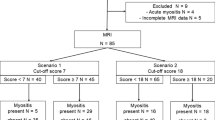Abstract
Objective
Idiopathic and diabetic-associated muscle necrosis are similar, uncommon clinical entities requiring conservative management and minimal intervention to avoid complications and prolonged hospitalization. An early noninvasive diagnosis is therefore essential. We evaluated the magnetic resonance imaging (MRI) characteristics of muscle necrosis in 14 patients, in eight of whom the diagnoses were confirmed histologically.
Design and patients
Two experienced musculoskeletal radiologists performed retrospective evaluations of the MRI studies of 14 patients with the diagnoses of skeletal muscle infarction. In 10 cases gadolinium-enhanced (T1-weighted fat-suppressed) sequences were available along with T1-weighted, T2-weighted images and STIR sequences, while in four cases contrast-enhanced images were not available.
Results
Eight patients had underlying diabetes and in six patients the cause of the myonecrosis was considered idiopathic. T1-weighted images demonstrated isointense swelling of the involved muscle, with mildly displaced fascial planes. There was effacement of the fat signal intensity within the muscle. Fat-suppressed T2-weighted images showed diffuse heterogeneous high signal intensity in the muscles suggestive of edema. Perifascial fluid collection was seen in eight cases. Subcutaneous edema was present in seven patients. Following intravenous gadolinium administration, MRI demonstrated a focal area of heterogeneously enhancing mass with peripheral enhancement. Within this focal lesion, linear dark areas were seen with serpentine enhancing streaks separating them in eight cases. In two cases, a central relatively nonenhancing mass with irregular margins and peripheral enhancement was noted. The peripheral enhancement involved a significant part of the muscle. No focal fluid collection was noted.
Conclusions
We believe that the constellation of imaging findings on T1- and T2-weighted images and post-gadolinium sequences is highly suggestive of muscle necrosis. We consider certain specific findings on gadolinium-enhanced images to be characteristic. The findings reported here should provide radiologists with useful information in making the diagnosis of skeletal muscle necrosis without resorting to invasive procedures.





Similar content being viewed by others
References
Angervall L, Stener B. Tumoriform focal muscular degeneration in two diabetic patients. Diabetologica 1965; 1:39–42
Banker BQ, Chester CS. Infarction of thigh mass in a diabetic patient. Neurology 1973; 23:667–667
Chester CS, Banker BQ. Focal infarction of muscle in diabetics. Diabetes Care 1986; 9:623–629
Lauro GR, Kissel JT, Simon SR. Idiopathic muscular infarction in a diabetic patient. Report of a case. J Bone Joint Surg Am 1991; 73:301–304
Bjornskov EK, Carry MR, Katz FH, Lefkowitz J, Ringel SP. Diabetic muscle infarction: a new perspective on pathogenesis and management. Neuromusc Disord 1995; 5:39–45
Khoury NJ, El-Khoury GY, Kathol MH. MRI diagnosis of diabetic muscle infarction: report of two cases. Skeletal Rad 1997; 26:122–127
Barohn RJ, Kissel JT. Case of the month. Painful thigh mass in a young woman: diabetic muscle infarction. Muscle Nerve 1992; 15:850–855
Reich S, Wiener SN, Chester S, Ruff R. Clinical and radiologic features of spontaneous muscle infarction in the diabetic. Clin Nucl Med 1985; 10:876–879
Ratliff JL, Matthews J, Blalock JC, Kasin JV. Infarction of the quadriceps muscle: a complication of diabetic vasculopathy. South Med J 1986; 79:1595
Hinton A, Heinrich SD, Craver R. Idiopathic diabetic muscle infarction: the role of ultrasound, CT, MRI, and biopsy. Orthopaedics 1993; 16:623–625
Nunez-Hoyo M, Gardener CL, Motta AO, Ashmead JW. Skeletal muscle infarction in diabetes. J CAT 1993; 18:986–988
Rocca PV, Alloway JA, Nashel DJ. Diabetic muscular infarction. Semin Arthritis Rheum 1993; 22:280–287
Kiers L. Diabetic muscular infarction: magnetic resonance imaging (MRI) avoids the need for biopsy. Muscle Nerve 1995; 18:129–130
Van Slyke MA, Ostrov BE. MRI evaluation of diabetic muscle infarction. Magn Reson Imaging 1995; 13:325–329
Ummiperez GE, Stiles RG, Kleinbart J, Krendel DA, Watts NB. Am J Med 1996; 101:245–250
Chason DP, Fleckenstein JL, Burns DK, Rojas G. Diabetic muscle infarction: radiologic evaluation. Skeletal Radiol 1996; 25:127–132
Vande Berg B, Malghem J, Putteman T, Vandeleene B, Lagneau G, Meldague B. Idiopathic muscular infarction in a diabetic patient. Skeletal Radiol 1996; 25:183–185
Keller DR, Erpelding M, Grist T. Diabetic muscular infarction: preventing morbidity by avoiding excisional biopsy. Arch Intern Med 1997; 157:1611–1612
Scully RE, Mark EJ, McNeely WF, Ebeling SH, Phillips LD. Weekly clinicopathologic exercises. N Engl J Med 1997; 337:839–845
Damron TA, Levinsohn EM, McQuail TM, Cohen H, Stadnick M, Rooney M. Idiopathic necrosis of skeletal muscle in patients who have diabetes. J Bone Joint Surg Am 1998; 80:262–267
Jelinek JS, Murphey MD, Aboulafia AJ, Dussault RG, Kaplan PA, Snearly WN. Muscle infarction in patients with diabetes mellitus: MR imaging findings. Radiology 1999; 211:241–247
Peters TJ, Martin F, Ward K. Chronic alcoholic skeletal myopathy- common and reversible. Alcohol 1985:2: 485–489
Valle DE, Kaakaji Y, Nietzschman HR. Case 2: Iatrogenic soleus muscle infarct. AJR Am J Roentgenol 1998; 171:865–867
Author information
Authors and Affiliations
Corresponding author
Rights and permissions
About this article
Cite this article
Kattapuram, T.M., Suri, R., Rosol, M.S. et al. Idiopathic and diabetic skeletal muscle necrosis: evaluation by magnetic resonance imaging. Skeletal Radiol 34, 203–209 (2005). https://doi.org/10.1007/s00256-004-0881-8
Received:
Revised:
Accepted:
Published:
Issue Date:
DOI: https://doi.org/10.1007/s00256-004-0881-8




